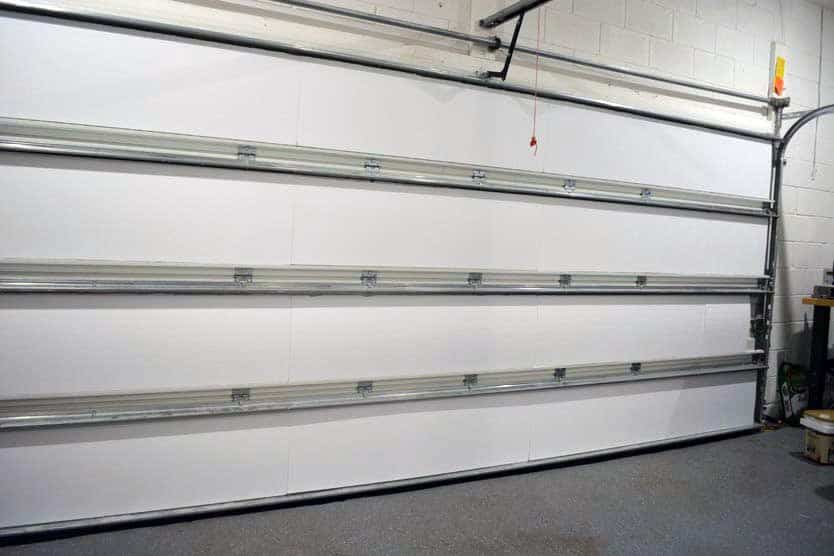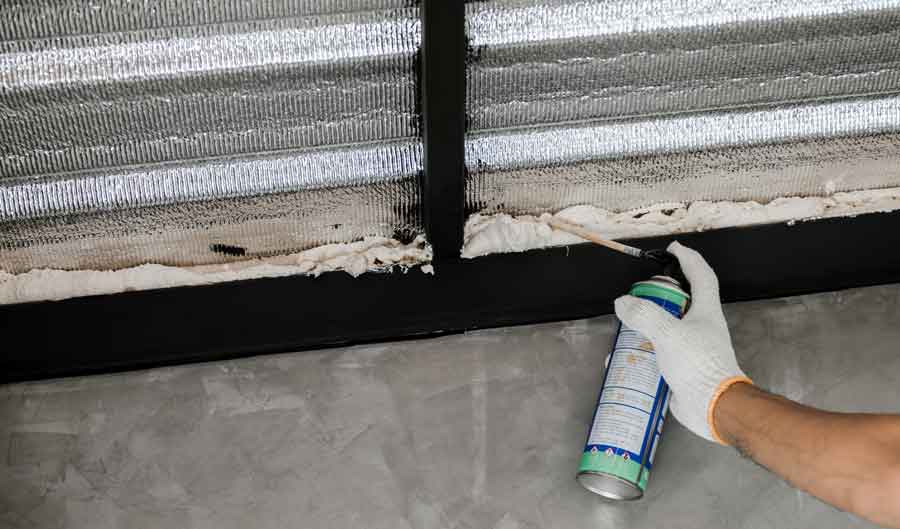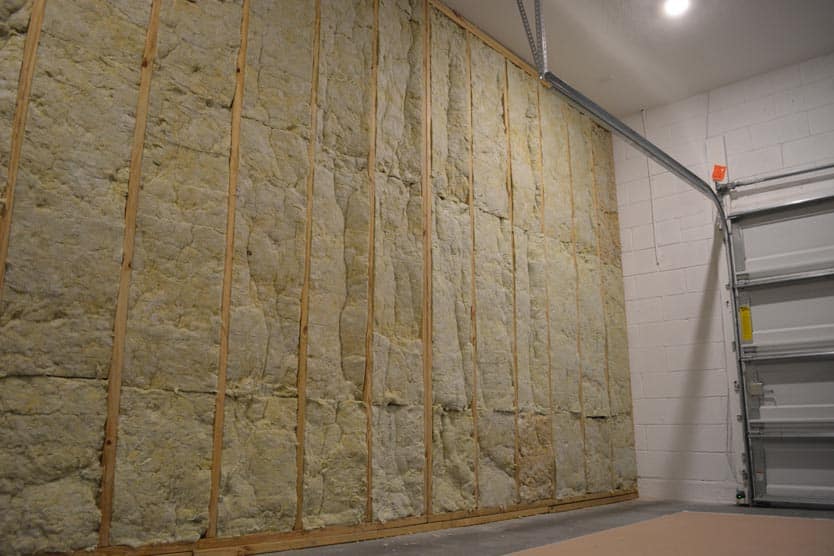In this article, we’ll explore some of the best cheap garage insulation options to help you save money on energy bills while keeping your garage warm and comfortable throughout the colder months.
While it’s true that many insulation options can be expensive, there are also affordable ways to insulate your garage without breaking the bank.
Whether you use your garage as a workshop, storage space, or simply a place to park your car, insulating it can make a big difference in your comfort and wallet.
So what is the cheapest way to insulate a garage?
Let’s dive in and explore your options!
The Cheapest Way to Insulate Garages: Garage Door Insulation
By far, the cheapest way to insulate garages is to start with the garage door.
Garage Door Insulation Kits
Brand-new insulated garage doors can easily cost between $2000 and $5000. DIY garage door insulation kits can improve your existing garage door’s energy efficiency at a fraction of the cost.
Installing a DIY garage door insulation kit can help reduce heat loss or gain in your garage and improve energy efficiency.
It also reduces noise transmission and helps deaden the sound of your garage door when it opens and closes.

These kits are available online and at most hardware stores and come with rigid foam insulation panels that can be cut to fit the size of your garage door. Each lightweight panel is made of polystyrene or polyurethane foam, providing good insulation.
You can see my review and installation guide of the Matador garage door insulation kit. It’s what I use in my garage.
The foam insulation panels can be attached to your garage door using adhesive or clips. In specific applications, the panels will slide into gaps in your garage door without needing any adhesive.
Installation of a DIY garage door insulation kit is relatively easy. It can be done with basic tools such as a utility knife, straight edge, and tape measure.
Insulating Blankets
Insulating blankets are a temporary solution, but they’re popular with many households because they’re one of the cheapest ways to insulate a garage.
They are made from a thick insulation material that’s hung inside your garage door. Made from materials such as fiberglass or polyester, they are lightweight, easy to handle, and can be cut to fit the size of your garage door.
However, there are also some disadvantages to using insulating blankets to cover your garage door.
For starters, they must be manually hung and taken down whenever you want to use your garage door.
Another disadvantage is how they look.
Some homeowners don’t like the look of heavy blankets hanging over their garage door. They also take up a fair amount of space in your garage, reducing your usable storage space.
Finally, insulating blankets are less effective than other insulation materials, such as polystyrene foam board or spray foam insulation.
Although insulation blankets are a cheap garage insulation idea, they are awful at reducing air leakage or preventing heat loss or gain.
Cheap Wall Insulation for Garages
We’ll start by looking at cheap ways to insulate your garage walls.
Each type of insulation is listed in order from the cheapest to the most expensive.
Seal Air Leaks
The first step in any insulation project is to seal any air leaks.
Air leaks can occur around windows, doors, electrical outlets, and other openings in your garage walls. This allows air to flow in and out of your garage, leading to heat loss or gain and decreasing the effectiveness of insulation materials.
Caulk is one of the most effective ways to seal air leaks in your garage walls. It can be applied to gaps or cracks around windows, doors, and other openings in your garage walls.
However, different types of caulk are available, so choose the proper type for your wall material to ensure a good seal. Examples include silicone or latex caulk.

Weatherstripping is another way to seal air leaks around doors and windows, reducing air leakage and improving energy efficiency in your garage.
It comes in various types, such as adhesive-backed foam tape, V-strip, or door sweeps.
Gap filler is a type of spray foam insulation packed to seal air leaks in your garage walls. Like other spray foam insulation, it expands to fill gaps and cavities between the studs, creating an airtight seal.
Don’t forget about the electrical outlet gaskets in your garage.
Installing outlet gaskets behind the cover plate can help seal these leaks and improve insulation. These gaskets are made of foam or rubber and can be found at most hardware stores.
Sealing air leaks will make whatever insulation you install later much more effective. It’s a cheap and easy step to insulate your garage and can significantly improve your comfort level and energy efficiency.
Foam Board Wall Panels
Rigid foam board insulation is the cheapest way to insulate your garage. It can also be one of the easiest to install.
Most polystyrene foam boards can be glued to your concrete, wood, or metal garage walls using construction adhesive. Alternatively, it can be cut to fit the space between the studs in your garage walls because it is lightweight and easy to handle.

It also provides a good barrier against moisture and can help reduce noise transmission. It’s important to note that foam board insulation is flammable and should be covered with a thermal barrier, such as drywall, to provide a fire barrier.
Polystyrene foam board is available in various thicknesses and R-values. Thicker foam board typically means a higher R-value.
Usually, this equates to an R-value of about R-4 per one inch of thickness.
The R-value measures thermal resistance, indicating how well the insulation material resists heat flow. The higher the R-value, the better the insulation material’s ability to resist heat flow.
As you’d expect, the cost of a polystyrene foam board varies depending on the thickness and R-value.
However, it is generally considered to be a cost-effective insulation material. It’s a relatively easy, straightforward DIY project that can be done with basic tools and materials.
Fiberglass or Rockwool Batt Insulation
Fiberglass or rockwool batt insulation is commonly used in residential and commercial construction and is readily available at most hardware stores.
Batt insulation comes in rolls or strips and can be easily installed between the studs in your garage walls. It is available in various R-values and thicknesses, allowing you to choose one that meets your insulation needs and budget.
The two most common types of batt insulation are fiberglass and rockwool. Although they both serve the same purpose of improving insulation and energy efficiency, they have some differences.
Rockwool batt insulation is made from natural stone and recycled materials, making it more environmentally friendly than fiberglass batt insulation. It typically has a higher R-value and is more moisture and fire-resistant than fiberglass batt insulation.

That said, fiberglass batt insulation is considerably less expensive than rockwool batt insulation.
As you’d expect, the cost of fiberglass or rockwool batt insulation varies depending on the R-value and thickness of the insulation.
Unlike rigid foam insulation, batt insulation cannot directly adhere to the wall. Since it works by trapping air in small pockets, it needs room to breathe.
That means if you don’t already have exposed studs on your garage walls, you’ll need to install them before you add batt insulation.
Even with the added cost of installing studs, fiberglass or rockwool batt insulation is an easy, cost-effective way to add insulation to your garage.
Spray Foam Insulation
Spray foam insulation is the most effective but ‘least cheap’ way to insulate a garage on this list.
It provides a higher level of insulation than other insulation materials, such as fiberglass or batt insulation, because it creates an airtight seal. This reduces the air leakage in your garage walls and prevents heat loss or gain. It is also resistant to moisture and can help prevent mold growth and water damage in your garage walls.
Spray foam insulation is made from two chemical components, creating a foam that expands and fills the gaps and cavities in your garage walls.
Although applied directly to your garage walls, it’s best used in-between wall studs. Similar to batt insulation, adding wall studs will add an additional cost if you don’t already have exposed studs.

Stores like Lowe’s and Home Depot sell spray foam insulation kits so homeowners can install it themselves. However, given the equipment needed and its complexity, I recommend having a professional do it instead.
Spray foam insulation can be installed in varying thicknesses. Thicker applications will yield a higher R-value.
Overall, spray foam insulation isn’t the cheapest way to insulate your garage but it is the most energy-efficient. It also helps prevent moisture and mold growth in your garage walls, making it a good investment for the long term.
Unlike the other options on this list, installing spray foam insulation in your garage should help increase your home’s value when you sell it down the road.
Why Radiant Barriers Aren’t Good
You’ll probably hear suggestions that radiant barriers are a cheap way to insulate your garage. I’m going to tell you otherwise.
A radiant barrier is a type of reflective insulation material designed to reflect heat and prevent heat from being absorbed by your garage walls.
While a radiant barrier can be an effective insulation option in certain situations, it is not the best or most cost-effective solution for a home garage.
First, a radiant barrier is most effective in hot climates with high radiant heat gain. Imagine the sun beating down on your roof, making it so hot you can feel the heat without touching it.
A radiant barrier is less effective in colder climates or during the winter months because it doesn’t prevent heat loss or convection heat transfer.
Second: a radiant barrier only works in one direction because it reflects heat back to the source.
It will help maximize your garage heater in the winter by keeping that heat inside your garage. However, that also means it will keep the summer heat inside as well.
A radiant barrier is only effective if installed correctly and with other insulation materials. A radiant barrier needs an air gap on the reflective side to work. Installing the reflective side of a radiant barrier directly against your garage wall renders it useless.
Finally, a radiant barrier does not provide a complete insulation solution. It reflects radiant heat but does not prevent heat loss or gain due to convection or air leakage.
Therefore, if you want to improve energy efficiency and comfort in your garage, a radiant barrier should be used with other insulation materials such as batt insulation or polystyrene foam board.

Cheapest Way to Insulate Garage Ceilings
Insulating your garage ceiling is typically beyond the scope of the average DIY homeowner. However, it can be a cost-effective way to improve energy efficiency and comfort in your garage.
Here are some cheap solutions for insulating your garage ceiling:
- Fiberglass batt insulation: Fiberglass batt insulation is installed between the ceiling joists using staples or wire. It’s relatively easy to install and can provide a good level of insulation.
- Polystyrene foam board: Polystyrene foam board can be cut to fit between the ceiling joists and attached using adhesive or screws.
- Blown-in insulation: Blown-in insulation is slightly more expensive but offers better energy efficiency than batt or foam board. It is typically made of loose insulation material such as cellulose or fiberglass and blown into the ceiling cavity using a special machine.
- Radiant barrier: A radiant barrier may be the perfect solution if your garage ceiling is also your roof. A radiant barrier is a reflective insulation material typically installed on the underside of the garage ceiling, facing away from the garage interior. This helps reflect the sun’s heat and keep your garage cooler during the hot summer months.
Overall, insulating your garage ceiling can be a cost-effective way to improve energy efficiency and comfort in your garage.
Choosing the right insulation material depends on your specific insulation needs and budget.
Wrapping It Up: Cheap Garage Insulation
Let’s wrap up what we’ve learned about cheap insulation for garages. Insulating your garage is a smart move to save on energy bills and keep the space comfortable.
Here’s a quick summary:
- Garage door insulation kits are the most budget-friendly way to start. They’re easy to install and effective.
- Insulating blankets are cheaper and temporary but not as effective.
- For walls, first seal any air leaks. Then, consider affordable foam board panels or fiberglass/rockwool batt insulation, which do a good job.
- Spray foam insulation costs more but offers the best energy efficiency.
- Avoid radiant barriers in cooler climates; they’re not very effective.
- For garage ceilings, fiberglass batts or foam boards are good options. Blown-in insulation is a bit pricier but very efficient.
Choose what works for your garage and budget. With these tips, you can make your garage warmer without spending too much.
Finally, the type of floor you have in your garage can make a big impact on how comfortable your garage feels. Check out this article next where we answer the question: “what is the best garage floor coating?“

